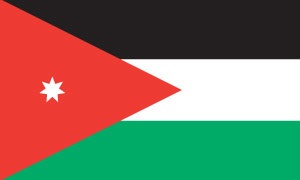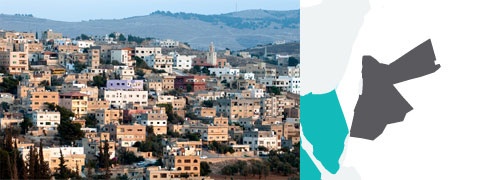Country assessments
Jordan
- Details
- Country assessments
2013 sector transition indicators
Source: EBRD.
Note: Water – Water and wastewater; IAOFS – Insurance and other financial services; PE – Private equity.
Highlights
- External and regional shocks have exacerbated fiscal and balance of payments pressures. Gas inflows from Egypt were severely reduced for most of 2012, resulting in the need to import expensive fuels, which led to a significant deterioration in the fiscal and current accounts.
- The state-owned power company, National Electric Power Company (NEPCO), made record losses, with payment arrears accumulating. NEPCO’s debt, which is government-guaranteed, reached 9 per cent of GDP in 2012, and the company continued to run arrears. In the meantime, electricity tariff increases were imposed in mid-August 2013 in response to NEPCO’s losses.
- Some initiatives have been taken to strengthen banking supervision and to develop capital markets. The Central Bank of Jordan has prioritised the strengthening of the supervisory framework, along with proposed improvements to bank governance. Legislation in relation to Islamic bonds (sukuk) was also passed at the end of 2012.
Key priorities for 2014
- Comprehensive reforms in the electricity sector are needed in order to bring NEPCO back to cost recovery. This should include further increases in electricity tariffs and better diversification of energy sources.
- Major reforms are still needed in the water and wastewater sector. Although the government has embarked on a number of large infrastructure projects, institutional reforms are still needed in order to enhance operational efficiency and reduce water wastage.
- Major investments in the agribusiness sector are needed in order to improve the food value chain. Much of the focus should be on enhancing water efficiency and quality, and on other logistical infrastructure to remove bottlenecks along the food value chain.
Macroeconomic performance
The Jordanian economy has continued its lacklustre performance, amid ongoing regional and external shocks. Real GDP grew on average by 2.8 per cent year-on-year in the first half of 2013, and by 2.7 per cent in 2012, which is well below the average growth rate of 6 per cent over the last decade. While private services expanded, agricultural and mining production have been weakening due to the disruption of transportation through Syria and labour strikes. In the meantime, the manufacturing sector remained sluggish. In light of subdued growth and moderating inflation, the Central Bank cut its policy rate by a cumulative 50 basis points in August and September 2013 - the first cuts since February 2010.
The fiscal and current accounts came under pressure in 2012. The rise in social spending, particularly on fuel subsidies, combined with lower domestic revenues, has contributed to the widening of the central government’s overall fiscal deficit (excluding grants), from 6.8 per cent of GDP in 2011 to 8.2 per cent in 2012. The current account deficit has also more than doubled in the past two years, reaching 18 per cent of GDP in 2012. This increase can be partly explained by lower grants and an inflated energy import bill, owing to the recent political turmoil in Egypt, which prevented normalisation in the supply of natural gas. Moreover, the crisis in Syria has led to a decline in exports, after the shutdown of Syrian transit routes, along with an increase in imports due to Syrian refugee demand. After coming under pressure in 2012, foreign exchange reserves have been partially rebuilt, rising from US$ 6.6 billion in December 2012 to US$ 11.7 billion in August 2013, as a result of tight monetary policy, sizeable foreign grants - mainly from Gulf Cooperation Council (GCC) countries and the United States - and two successful US dollar-denominated bond issues. This has led to a decline in both deficits during the first half of 2013.
A fiscal consolidation plan centred on energy subsidy reform is in place. In November 2012 the government implemented increases in fuel prices across the board, accompanied by targeted cash transfers. Moreover, NPECO raised electricity tariffs by 15 per cent in mid-August 2013 (excluding households) in response to its mounting losses, which reached 9 per cent of GDP in 2012.
Risks to economic growth remain tilted to the downside, reflecting regional political turmoil. The increasing numbers of Syrian refugees, along with the disruption of trade routes through Syria, continue to strain Jordan’s economy. Furthermore, the heightened political and security situation in Egypt could adversely affect natural gas supplies to Jordan and pose a risk to the balance of payments.
Major structural reform developments
Despite some reform efforts, key impediments to the business environment remain. A new Competition Law, designed to modernise the current law of 2004, is expected to be passed by the parliament in late 2013. Nevertheless, the Competition Directorate is not independent, and lacks capacity, while anti-competitive practices still persist in an economy with many concentrated sectors. Jordan ranked one hundred and nineteenth of 189 countries in the World Bank 2014 Doing Business report. Although the minimum capital requirements for starting a business were significantly reduced in 2012, and cross-border trade has been facilitated, many bureaucratic impediments to doing business remain. Despite the fact that the Jordan Investment Board (JIB) has worked to streamline the process of business start-ups, foreign and domestic investors still face extensive red tape and opaque procedures, particularly at the local government level. Significant challenges still exist in protecting investors and enforcing contracts. A new insolvency and bankruptcy draft law was, as of late October 2013, pending parliamentary review. In addition, a draft investment promotion law, which sets up a one-stop shop for investors, is also awaiting parliamentary review.
Energy sector reform remains one of Jordan’s top priorities. The state-owned power company, NEPCO, has suffered record losses, and did not repay its end-2011 arrears of about 2 per cent of GDP. In addition, its debt, which is government-guaranteed, reached 9 per cent of GDP in 2012. To ease the associated fiscal burden on the budget, the government increased fuel prices across the board in November 2012 (with continuous alterations on a monthly basis in line with international price trends), accompanied by targeted cash transfers to approximately 70 per cent of the population. In addition, electricity tariffs were increased in August 2013 in response to NEPCO’s losses.
Jordan has made substantial progress on financial sector reforms. The Central Bank has strengthened regulation by stepping up off-site monitoring of banks and starting the process of introducing Basel III. It is also helping a private firm to complete the final technical steps for the licensing of the first credit bureau, which is expected to be completed by the end of 2013. In addition, consumer protection regulation was passed in 2012, increasing the transparency of bank customer rules. The Central Bank is also updating the corporate governance code, and plans to issue updated regulations in 2013. However, despite the banking sector’s relative resilience in the face of regional turmoil, access to finance remains an impediment, especially for micro, small and medium-sized enterprises. However, the low effectiveness of enforcement of bankruptcy procedures among borrowers is a significant impediment to expanding access to finance. Further, the state’s heavy reliance on bank lending has increased banks’ sovereign exposures. Jordan approved a law on Islamic bonds, or sukuk, in late 2012, allowing both government and private sector companies to issue sukuk in domestic and international markets.
Major reforms are still lagging in the water and wastewater sector. Although the government has embarked on a number of large infrastructure projects (such as the Disi Water Conveyance Project, which came online in July 2013 to increase water supply to the capital), institutional reforms that are necessary to enhance operational efficiency and reduce water waste have not yet been introduced. Water scarcity is a key development challenge for Jordan. The government-controlled Water Authority for Jordan (WAJ), which is responsible for large investments such as infrastructure construction, is heavily subsidised by the state, and tariffs are not reflective of either costs or water scarcity.
Further reforms are planned to increase competition in the telecommunications sector. In December 2012 the Telecommunications Regulatory Commission (TRC) announced a reform push to increase Jordan’s information and telecommunications technology potential. Aside from seeking stronger powers, the TRC plans to open the fixed broadband and narrowband markets, ease market access for new service providers and enhance legal and regulatory measures to deal with new technologies, such as 4G mobile services (a new auction for frequencies is expected in 2013). Nevertheless, the telecommunications sector in Jordan remains one of the most competitive in the Arab region, with past privatisations leading to a rapid growth in services and a reduction in prices.













